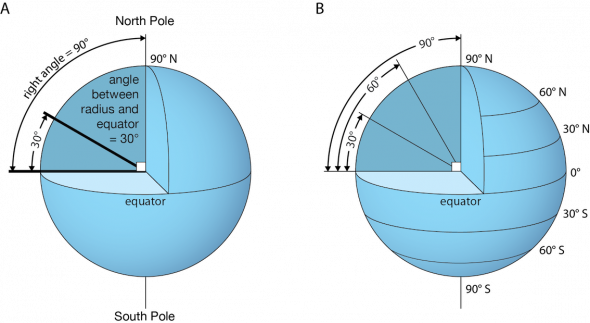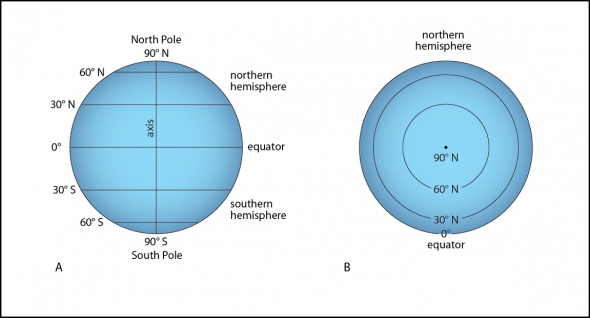Special Names On A Globe
When describing location, it is common to mention the metropolis, state, or country as a location descriptor. It is also common to talk about landmarks that may be nearby. Some other way to depict location is to use reference lines to describe coordinates, or absolute position, on the globe.
Two types of imaginary reference lines are used to locate positions or points and to brand accurate globes and maps. These lines are called parallels of latitude and meridians of longitude. Two of these imaginary reference lines, the equator and the prime pinnacle, are called main reference lines because they are where nosotros showtime the numbering system.
Equator, Hemispheres, Axis, and Directions

The earth rotates daily about its axis. The north and due south poles are the ii imaginary points where the axis would enter and exit from the earth if the centrality were a pole or a line (run into Fig. 1.9). The equatoris the imaginary primary reference line fatigued around the earth halfway betwixt the north and south poles. The one-half of the earth to the north of the equator is the northern hemisphere; the half to the s is the southern hemisphere (Fig. i.9). (The prefix hemi- means "one-half"; thus, hemisphere means "half-sphere.") The poles make up one's mind north and southward directions. Move toward the North Pole is northerly in direction. Movement toward the S Pole is southerly in direction.
Parallels of Latitude
Latitude is measured in degrees (°)—from 0˚ to xc˚—north or south of the equator. Degrees of latitude are measured from an imaginary point at the center of the world. If the earth was cut in half, this imaginary point would be intersected past a line drawn from the N Pole to the South Pole and by a line fatigued from the equator on one side of the globe to the equator on the other (Fig. 1.10 A). A radius is a line drawn from the border of a circle to its centre. The bending between the radius lines drawn from the equator and from the north pole (or southward pole) forms a correct angle, which is ninety°.

The equator is at 0°, and both of the earth'southward poles are at ninety° from the equator. Latitude is determined past the bending between a bespeak on the earth'southward surface and the equator. To summate the angle, draw a line from the indicate to the centre of the earth and a line from the equator to the center of the earth (Fig. 1.ten A).
Parallels of latitude are imaginary reference lines that form complete circles effectually the earth parallel to the equator and parallel to each other. Every point on a parallel of latitude is the same altitude from the equator, and thus the angle formed between the equator and the breadth line is abiding. This is shown in Fig. 1.10 B for the breadth lines 30° and sixty° due north.
Parallels of breadth are circles of unlike sizes (see Fig. i.11). The largest parallel is at the equator, and the parallels decrease in size towards the poles. Except for positions located right on the equator (0°), parallels of latitude are described by the number of degrees that they are north (Due north) or south (S) of the equator. The greater the distance from the equator, either north or south, the higher the latitude. Honolulu, Hawai'i, for example, is on the 21° N parallel. Sydney, Australia, is on the 34° S parallel.

Meridians of Longitude
Meridians of longitude are imaginary half-circles running from the N Pole to the South Pole. They are sometimes called lines of longitude. Unlike parallels of breadth that are different sizes, all lines of longitude are the same length. Since every pinnacle must cross the equator, and since the equator is a circumvolve, the equatorial circle can exist divided into 360°. These divisions of the equatorial circumvolve are used to characterization the meridians.
By international agreement, the 0˚ meridian (likewise called the prime meridian) is drawn through Greenwich, England. Meridians are numbered east and westward from the prime meridian (Fig. 1.12 A).


Longitude is the altitude east or due west of the prime meridian, and longitude is measured in degrees from 0˚ to 180˚ (Fig. i.12 B). Places to the due east of the prime meridian have east longitude. Rome, Italy, for case, is located on the 12˚ E superlative, whereas Washington DC, U.s.a., is located on the 77˚ W acme.
Due east and west longitude meet at the 180˚ top, which runs through the Pacific body of water basin (Fig. 1.xiii). Therefore, most of the United States (including Hawai'i) lies in the western hemisphere. Merely a small portion of Alaska (part of the Aleutian Islands) crosses the 180˚ top into the eastern hemisphere. The complete circle around the earth made by the prime number summit (0˚) and the 180˚ meridian divide the world into eastern and western hemispheres (see Figs. 1.12 and ane.13).
International Date Line

The international date line is an imaginary line running mostly along the 180˚ meridian (run across Fig. 1.14). The international engagement line determines where on world the appointment changes. For example, at the same moment the time is 6:00 am on July 1st in Bangladesh, the time is 6:00 pm on June 30th in Mexico and midnight on June 30th in England (see Fig. one.15 A).
Places located immediately to the correct and left of the date line are 24 hours apart. This ways that on the left side of the international appointment line in Tonga, when the time is noon on Monday, July 1st, on the right side of the date line in Sāmoa, the time is noon on Sunday, June 30th (see Fig. 1.15 B).


Travelers who cantankerous the dateline heading west lose a mean solar day, but travelers who cross the dateline going east gain a day. When traveling east beyond the dateline, information technology is actually possible to arrive at your destination earlier than when you left!
For practical purposes, the international appointment line has been adapted to let certain country areas to remain together in the same solar day and time zones. For example, the extreme eastern tip of Russian federation, which juts into the Bering Strait, was kept in the easternmost fourth dimension zone, whereas the U.S.-owned Aleutian Islands were kept equally function of the westernmost time zone (see Fig. 1.15 B).

In some other instance, the country of Kiribati (pronounced KIRR-i-bas) drastically changed the engagement line in 1995 and so that the entire country could be on the same day at the same fourth dimension. Earlier this, the western role of Kiribati, where the capital lies, would be 22 hours alee of the eastern portion of the county. Now eastern Kiribati and Hawai'i, which are located close to the same longitude, are a whole day apart (see Fig. 1.sixteen).
Location

Lines of breadth and longitude class an imaginary global filigree system, shown in Fig. 1.17. Whatsoever point on the world tin can exist located exactly by specifying its latitude and longitude. This system is essential for ships at sea that cannot locate their positions using landmarks or coastal navigational aids such equally buoys or channel markers. This organization is just as useful for people on land when hiking, driving, or surveying an environs.
To locate a point on a globe exactly, degrees of latitude and longitude are further subdivided into minutes and seconds. In latitude and longitude measurements, minutes and seconds practice not refer to time. Instead, they refer to parts of an angle. But, like with time, in that location are 60 minutes in a degree (only as there are sixty minutes in an hour). Similarly, there are 60 seconds in a minute of time and 60 seconds in a infinitesimal of longitude or latitude.
1 degree (1°) = 60 minutes (60')
ane minute (one') = sixty seconds (60")

The breadth and longitude readings of a identify are called its spherical coordinates. For example, the coordinates of the location of the USS Arizona Memorial in Pearl Harbor (Fig. 1.18) are "latitude 21 degrees, 21 minutes, and 54 seconds north; longitude 157 degrees, 57 minutes, and zero seconds west." This is written as "21° 21' 54" N, 157° 57' 0" W".
Activity: Locating Points on a Globe
Make a globe marked with reference lines of latitude and longitude.
Activity: Mapping the Globe
Make iii maps of a globe: an orthographic-project map, a cylindrical-projection map, and an equal-surface area map.
Latitude and Longitude Utilise
If the breadth and longitude coordinates of a location are known, it can exist pinpointed on a map or globe. Knowing the spherical coordinates of a location is useful for people when hiking, diving, or surveying an surround. Sophisticated navigational aids use breadth and longitude to requite directions when driving and flight. The spherical coordinate system is essential for ships at body of water that cannot locate their positions using landmarks or coastal navigation aids like buoys or channel markers.
Nautical Miles and Knots
In addition to using breadth and longitude to specify location, marine and air navigators also utilise the nautical mile as their unit of measurement of length or distance. A nautical mile is approximately one infinitesimal of latitude along a line of longitude, a distance of 1.85 kilometers. Navigators draw the speed of ships and airplanes in knots. Meteorologists besides depict wind speeds in knots. One knot is equal to one nautical mile per hr.
1 nautical mile = 1.85 km
ane knot = i nautical mile/hr
Activeness: Pacific Scavenger Hunt
Complete a location scavenger hunt using a map of the S Pacific ocean bowl.
Special Names On A Globe,
Source: https://manoa.hawaii.edu/exploringourfluidearth/physical/world-ocean/locating-points-globe
Posted by: shellenbargerjuplage.blogspot.com


0 Response to "Special Names On A Globe"
Post a Comment